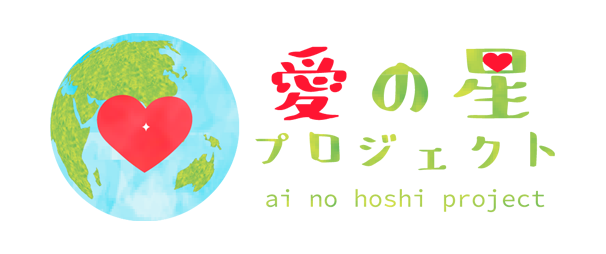Many children and civilians are still under threat due to Russia's military invasion of Ukraine that began in February 2022. UNICEF has announced a long-term support plan and is asking the international community for approximately $949 million (approximately 118.6 billion yen)*1 in assistance. On the other hand, Russia's military spending is said to be as much as $20 billion*2 (about 2.6 trillion yen) per day, including the loss of weapons, and enormous military expenditures are being made every day.
What is the world's military spending?
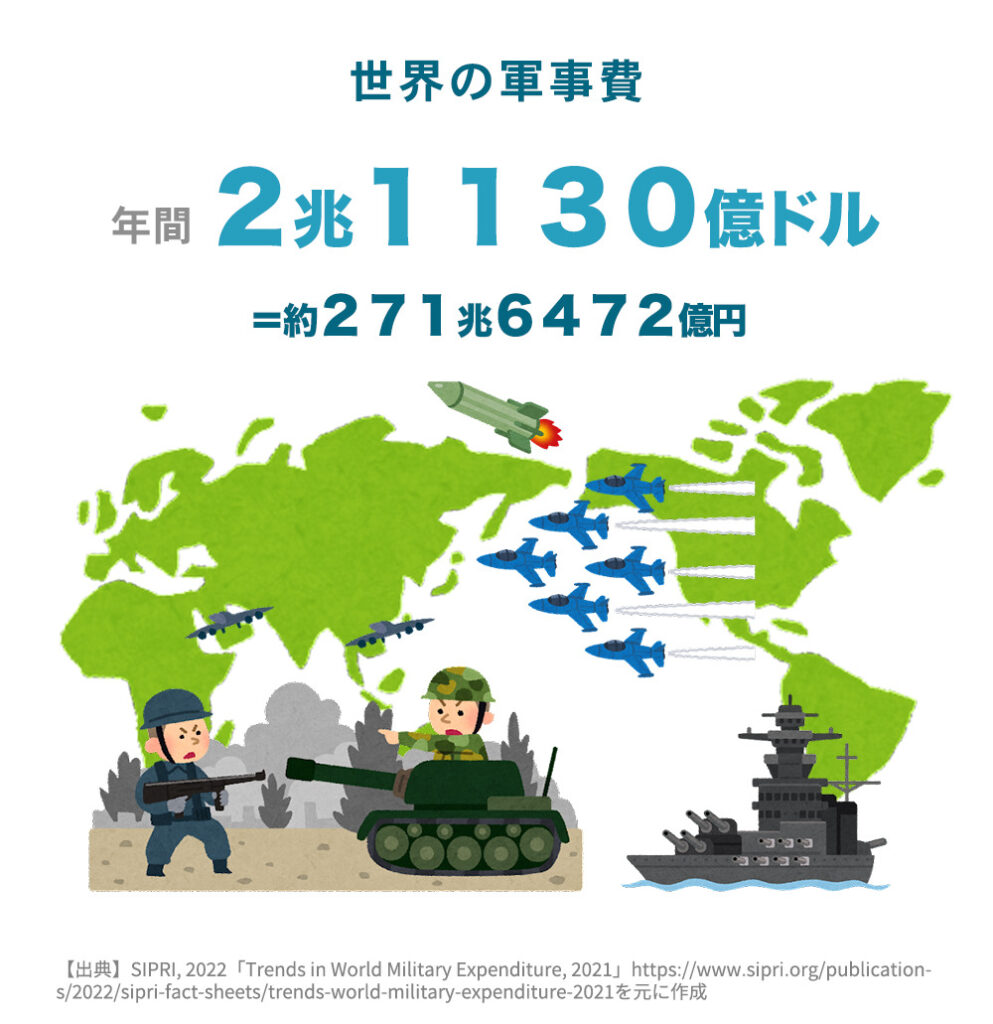
The Stockholm International Peace Research Institute in Sweden announced that the world's military spending in 2021 was $2.113 trillion (about ¥27.6472 trillion)*3, a record high. Military spending, also known as defense spending, is used to maintain the military when war is not occurring and as warfare expenses when war does occur. It includes military personnel costs, procurement and maintenance of weapons, etc., but the budgetary classifications seem to differ from country to country. In the case of Japan, the Self-Defense Forces' disaster relief efforts are also included, so not all costs are necessarily related to war or military policy, but it is true that the overwhelming majority of costs are allocated to strengthening and maintaining military equipment. Against the backdrop of the recent rise in international tensions, the world's military expenditures have continued to increase as more and more countries build up their armaments. It has been estimated that it costs tens of millions of yen to manufacture a tank used in the Russian military invasion, and more than 400 million yen*4 for a new model, and when missiles, fighter jets, and other weapons are combined, military expenditures are in the trillions.


What a year's worth of global military spending could do.
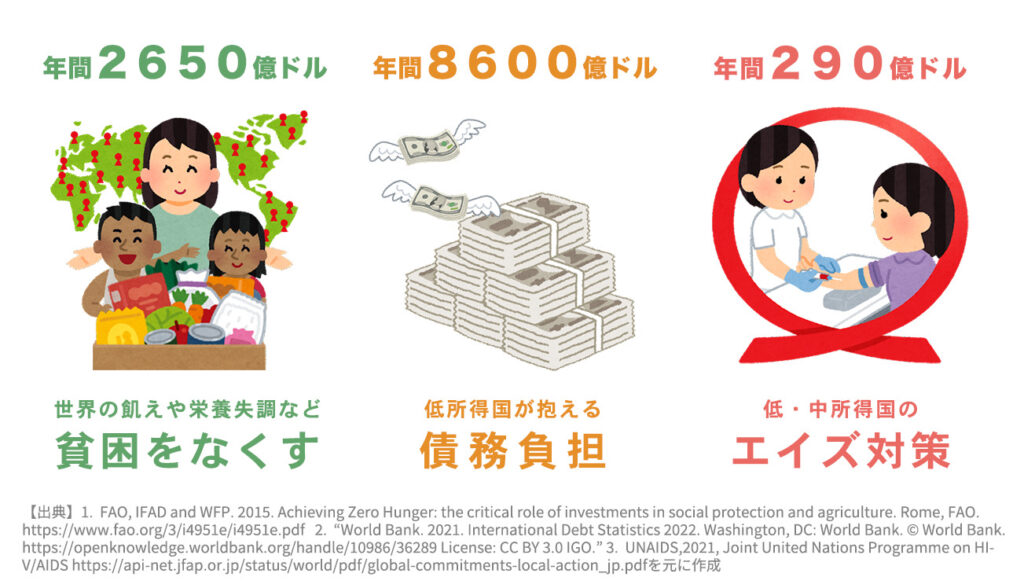
・Eliminate world hunger, malnutrition, and other forms of poverty $265 billion per year
A 2015 report by the Food and Agriculture Organization of the United Nations (FAO) found that the cost of permanently eradicating poverty, including hunger and malnutrition, would require $265 billion annually for 15 years*5. This amounts to about 13%*6 of the world's annual military expenditure. It is a figure that seems by no means impossible. UNICEF's total support for 2020 is $7.548 billion*7, which shows how much of the world's money is spent on military spending.
・Debt burden of low-income countries: $860 billion per year
According to a UNICEF report, one out of eight countries in the world spends more on debt than on social services*8, making the debt burden faced by low-income countries a serious problem. The debt burden held by low-income countries around the world increased by 12% to a record $860 billion*9 in 2020, partly due to the impact of the new coronavirus. As a result, budgets for child protection, education, social security, and health and sanitation are being reduced in debt-ridden countries. UNICEF is calling for international organizations, creditors, and governments to work together to reduce the debt burden and achieve sustainable recovery.
・AIDS control in low- and middle-income countries $29 billion per year
The Joint United Nations Programme on HIV/AIDS (UNAIDS) estimates that the amount of funding needed to end AIDS in low- and middle-income countries to address HIV by 2025 is $29 billion per year*.10 Meeting the 2025 AIDS target would provide HIV-related services to 95% of those in need, reducing the number of new HIV infections from 1.5 million to less than 370,000 by 2025. 020, reducing the number of new HIV infections from 1.5 million to less than 370,000. It also estimates that AIDS-related deaths could be reduced from 690,000 to less than 250,000 per year*11.


・Saves 3.3 million lives by providing education and medical services to 262 million children who are out of school $40 billion
According to Oxfam International, a 0.5% tax on the assets of the richest 1% of the world's population would raise more than $400 billion a year (about ¥44 trillion) and save 3.3 million lives by providing medical services in addition to educating 262 million children who are out of school*13. 13. This cost, in addition to the above three, could all be carried out with one year's worth of global military spending. In addition, the number of children out of school around the world is increasing as countries are forced to cut education budgets due to rising medical costs caused by new coronavirus infections and economic recession. According to a Save the Children report, $50 billion (approximately 5.1879 trillion yen)*14 is needed to help 136 million children living in the poorest countries safely return to school.
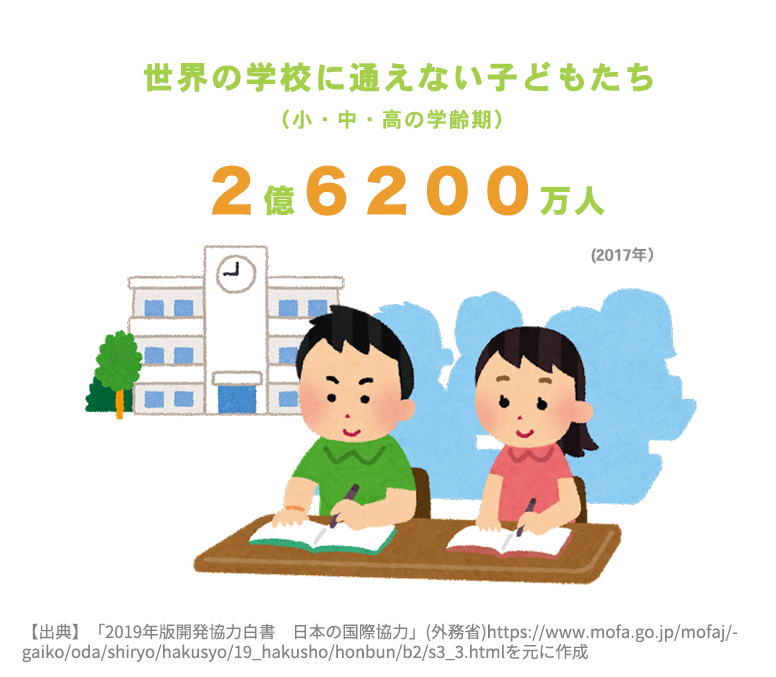
Military Spending on Education! Costa Rica's Efforts
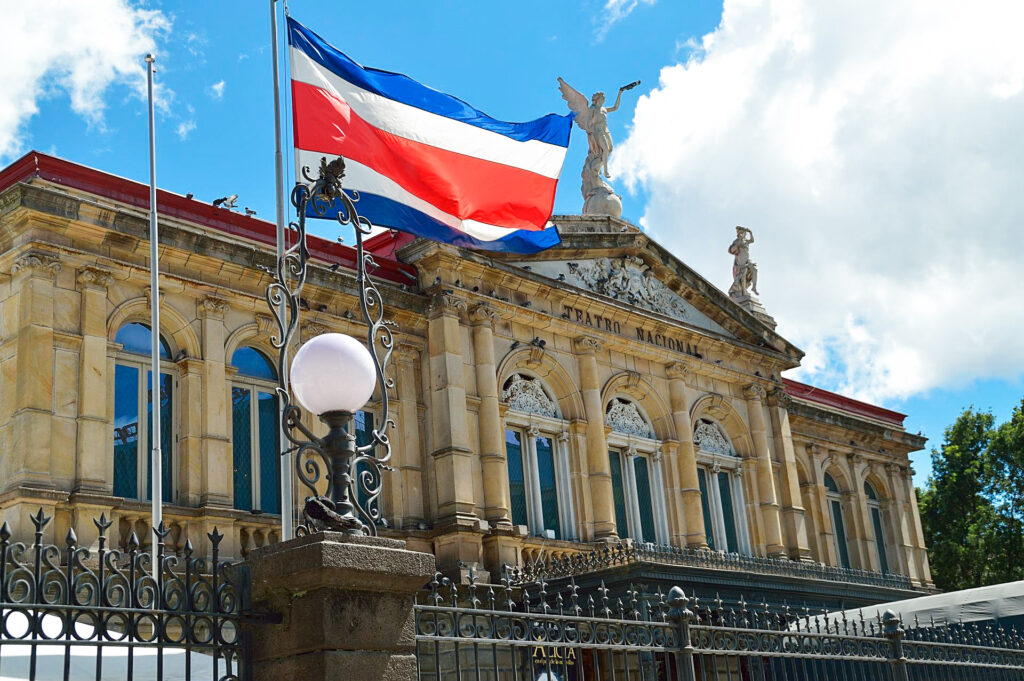


Costa Rica, a small happy country in Central America, was ranked No. 1*15 in the “Happiness on Earth Index (HPI)” ranking in 2021, and abolished its military after the civil war in 1984 in which many people lost their lives. By reducing the military budget to zero, Costa Rica is a country that has built a peaceful nation by using 30% of the national budget previously invested in the military for education, healthcare, and environmental conservation. Under the slogan “more teachers than soldiers,” Costa Rica has made education free from kindergarten through high school. The literacy rate is 98%*16, indicating the high level of education. Costa Rica is also famous for its rich biodiversity, with approximately 5% of all species found on the earth, or about 95,000 species, living in the country. Costa Rica also has a strong environmental policy, and almost all of the country's electricity is generated from renewable energy sources. While Costa Rica is under pressure to rebuild its finances due to the recent economic downturn and increase in immigration, it was one of the first countries to abolish its military, allocate its military budget to social welfare, and take steps toward “happiness” for its people and the global environment. In a world of increasing international tension, this is an essential and important way of being a nation.
For all people in the world to live happily
In his speech in Japan, former Uruguayan President Jose Mujica, known as “the poorest president in the world” and loved by the world, included the following passage.
Today, we live in an era of great wealth, scientific progress, and medical advances. In these times, the important question we must ask ourselves is, "Are we living happily now? (1). Of course, one aspect has had a very positive effect. For example, our life expectancy is 40 years longer than it was 150 years ago. On the other hand, we are spending $2 million every minute on the military.
For us, there is nothing more important than life. That means that the life of every person who has a life is important. Whether we think about the world, life, or trade, or work, we must start with "how to be happy.
[quoting] “The aim is a small world,” Jose Mujica, the world's poorest president (Part 2), April 14, 2016, https://www.kanaloco.jp/news/life/entry-74340.html


As of 2022, the world spends $4 million*17 per minute on military spending (approximately $520 million as of June 2022). We, the human race, must ask ourselves, “Are we living happily now?” We may be at a turning point where we need to rethink this question and reconsider our way of life. The future of the earth depends on the nations of the world joining forces and taking the helm for the “happiness” of all the world's children and all life.
*1[Source] “Ukraine and Refugee Outflow Appeal” UNICEF
https://www.unicef.org/appeals/ukraine
*2 [Source] Consulting Europe
3 [Source] “Global Military Expenditure Trends (2021),” Stockholm International Peace Research Institute (SIPRI)https://www.consultancy.eu/news/amp/7433/research-ukraine-war-costs-russian-military-20-billion-per-day
https://www.sipri.org/publications/2022/sipri-fact-sheets/trends-world-military-expenditure-2021
*4 [Source] MBS News (220404)
https://www.mbs.jp/news/feature/kansai/article/2022/04/088402.shtml#:~:text=%E4%BE%B5%E6%94%BB%E3%82%92%E8%A1%8C%E3%81%86%E3%83%AD %E3%82%B7%E3%82%A2%E5%81%B4,%E3%81%AA%E3%81%A9%E3%82%92%E5%88%86%E6%9E%90%E3%81%97%E3%81%BE%E3%81%99%E3%80%82
*5 [Source] FAO, IFAD, WFP. 2015. Achieving zero hunger: the critical role of social protection and investment in agriculture. Rome, FAO.
Available at: https://www.fao.org/3/i4951e/i4951e.pdf
*6The above data are calculated based on 3*5 data.
7[Source] Response to COVID-19: UNICEF Annual Report 2020. New York: United Nations Children's Fund (UNICEF), 2020.
Available at: https://www.unicef.org/reports/unicef-annual-report-2020
*8 [Source] UNICEF, (2021). COVID-19 and the Looming Debt Crisis: Protecting and Transforming Social Spending for Inclusive Recoveries, Innocenti Research Report no,https://www.unicef-irc.org/publications/pdf/Social-spending-series_COVID-19-and-the-looming-debt-crisis.pdf
*9 [Source] “World Bank.” 2021. International Debt Statistics 2022. Washington, DC: World Bank. © World Bank.
https://openknowledge.worldbank.org/handle/10986/36289 License: cc by 3.0 igo.”
*10*11 [Source] unaids.2021.global commitments,local action
https://api-net.jfap.or.jp/status/world/pdf/global-commitments-local-action_jp.pdf
*12[Source] FAO, IFAD, UNICEF, WFP, WHO. 2021. State of global food security and nutrition 2021. Transforming Food Systems for Food Security, Improved Nutrition and Affordable Healthy Diets for All. Rome, FAO.
Available at: https://www.fao.org/3/cb4474en/cb4474en.pdf
*13 [Source] OXFAM International.2019.Public good orprivate wealth?
https://www.oxfam.org/en/research/public-good-or-private-wealth
*14 [Source] Save the Children.
https://www.savethechildren.net/news/world%E2%80%99s-poorest-children-can-safely-go-back-school-if-leaders-invest-370-student#
*15 [Source] Wellbeing Economy Alliance.https://weall.org/the-latest-happy-planet-index-costa-rica-tops-the-list-beating-western-economies-on-sustainable-wellbeing
*16 [Source] Republic of Costa Rica (Republic of Costa Rica) Basic Data (Ministry of Foreign Affairs)
https://www.mofa.go.jp/mofaj/area/costarica/data.html#:~:text=%EF%BC%884%EF%BC%89%E3%82%B3%E3%82%B9%E3%82%BF%E3%83%AA%E3%82%AB%E3% 81%AF%E3%80%811949,%E4%BD%93%E5%88%B6%E3%82%92%E6%94%AF%E3%81%88%E3%81%A6%E3%81%84%E3%82%8B%E3%80%82
*17Calculated based on the data above*3
